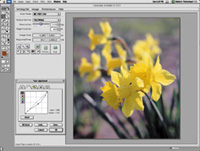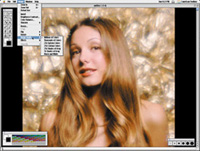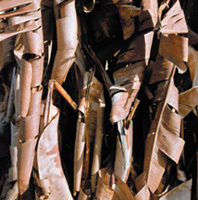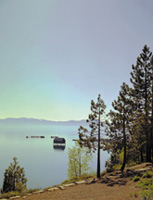The Canon CanoScan D2400UF Flat Bed Scanner
|
Flat-bed scanners with a high-resolution specification are usually accompanied by a film scanning capability. Reflective scanning rarely requires much more than 600dpi, but film scanning demands much more resolution. With a hardware resolution of 2400dpi, the new Canon CanoScan D2400UF definitely is as much a film scanning as a print scanning solution. With an estimated street price of $499, this new CanoScan model offers high film scanning resolution at a level accessible to many digital darkroom enthusiasts. Capable of scanning a 21/4" square film frame resulting in a hardware resolution scan equaling a print image file size of 16x16" at 300dpi, this new D2400UF should fulfill the desires of many photographers with serious intentions. And, unlike a previous CanoScan model I reported on some time back, this new D2400UF model does 2400dpi film scans at a competitive speed, thanks to Canon's new Galileo lens that gets more light to its six line CCD sensor. The professional-level specifications also include both 48-bit input and selectable output of 24 and 48-bit color depth. |
||||
This new Canon CanoScan D2400UF scanner is a sleek, compact design. The film scanning light source Film Adapter FAU-S13 in its lid covers an area sufficient to scan one 4x5 film image. A set of well designed film holders for 35mm, 120, and 4x5 are included. The scanner has a USB interface and software driver support is included for use with both Apple Macintosh and PC Windows computers. The Canon ScanGear software included with the scanner also provides a basic, complete image-editing capability. The scanner driver includes Canon Data Compression Transfer technology, which speeds up the movement of the scan data from the scanner to the host computer and application from which the scanning is being accomplished. Another proprietary processing advantage included by Canon is FARE (Film Automatic Retouching and Enhancement) providing an efficient, easy way to output clean optimized film scans. This function utilizes an infrared light source and sensor to detect dirt and defects so they may be automatically replaced by surrounding image information. Using The Canon CanoScan
D2400UF |
||||
Software Link With both the Windows PC operating system and the Macintosh operating system, the factory profiles were effective, providing a precise match between the adjusted preview and the final scan as it was opened in Photoshop. The good design of the film holders and the speedy efficiency of this new Canon flat-bed allowed me to do a considerable amount of full optical resolution scans of a variety of medium and large format film images in a surprisingly short amount of time. And, even though these scans were made of film that was old and that was not that great originally, and even had in some cases a fairly significant color cast from differential dye fading, very little post-scan editing was required. The major adjustment was mostly selective color in Hue &Saturation, necessary to eliminate mid-tone color casts. |
||||
With some of the film, particularly the 40 to 50-year-old color negatives, I had serious doubts that I would get decent images. However, even with old Kodacolor and the Agfa CN-17 that had no dye base (just clear film), I was able to scan with surprising success. The clear CN-17 film base makes the use of the scanner software negative conversion ineffective because it assumes there is an orange-brown base color. It resulted in an excessively blue result that was too strong a color cast to remove successfully. The CN-17 required an atypical technique of first making a positive scan in 48-bit mode, and then optimizing the resulting image file in Photoshop, followed by the Adjust/ Invert command, and then optimizing the image with the Levels dialog. I took particular pains to select black and white silver-based film negatives to test scan that included finely detailed subjects captured sharply with a Rollei or Hasselblad. This was in part to assure that I could evaluate scanning sharpness, as the old color films I was test scanning were not all that sharp even when exposed with the best optics. This revealed the only significant compromise in the affordable D2400UF. I found I had to apply somewhat more sharpening with Photoshop's Unsharp Mask filter post-scan than I liked to provide a crisp looking print image. Even then, with finer grain films, some of the subject detail was still not reproduced distinctly. It might be unrealistic, however, to expect that the CanoScan D2400UF would be comparable to scanners with the same resolution capability or greater and costing eight to 20 times as much. |
||||
Evaluation And Recommendation |
||||
Technical Specifications
|
- Log in or register to post comments








































